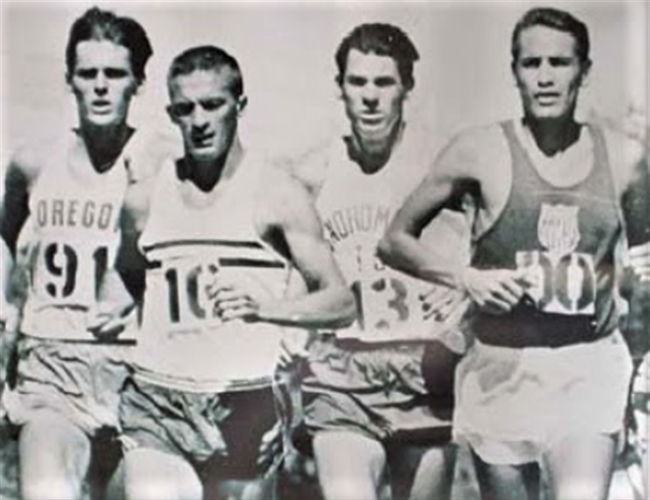The first U.S. Olympic Marathon Trials for men was held in 1968, for women in 1984. That means there have been a total of 22 Trials races leading up to Atlanta on Feb. 29. The men’s and women’s marathons were held separately—on different dates/different locations—through 2008. In 2012, this arrangement changed to same date/same place with events in Houston, Los Angeles (2016), and now Atlanta.
I’ve attended all these events, save Eugene, 1976, as either competitor or writer. Here are my picks for the six most significant, and what we, as runners, can learn from them.
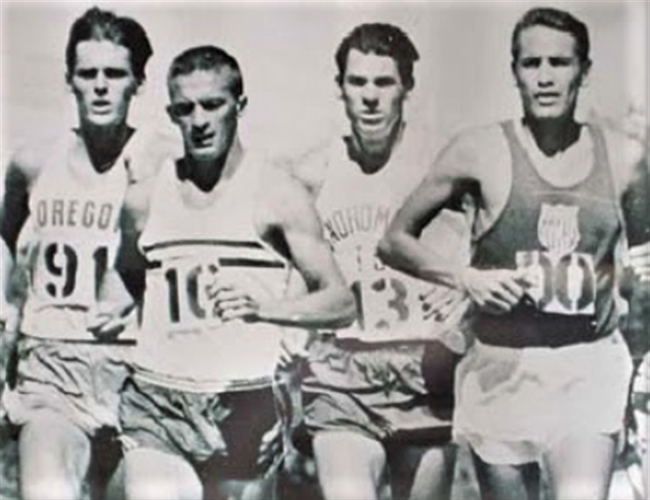
1968 Men’s Marathon Trials, Alamosa, Colorado
Prior to the first men’s Trials in Alamosa, U.S. Olympic marathoners had been chosen by their performances in several key marathons—usually Boston, Yonkers, and Culver City, California. This led to occasional selection controversies, as you might imagine. In track and field, on the other hand, Olympians were generally self-selected at a single Track Trials competition.
This process came to the marathon for the first time in 1968. The race was held in Alamosa, due to its high altitude—like that year’s Olympics in Mexico City. The race director was the then-little-known Joe Vigil, coach at Adams State College.
The two most talented runners in the field—George Young and Kenny Moore—finished 1-2 in the Olympic Marathon Trials, while the unspectacular but training- and-race-savvy Ron Daws nabbed the all-important third position.
Lesson Learned: Daws was one of the first to understand the importance of race simulations. One day in Alamosa, he ran the first mile of the course 10 times at marathon pace. Extreme? Sure. But a modest amount of marathon-pace-running always pays dividends
Postscript: Young finished 16th in the Olympic Marathon but won the bronze medal in his best event—the 3000-meter steeplechase. Four years later, he made his fourth straight Olympic team, this time in the 5000 meters, while Moore qualified for the marathon again.
- Young, George 2:30:48
- Moore, Kenny 2:31:47
- Daws, Ron 2:33:09
- Deines, Bob 2:33:13
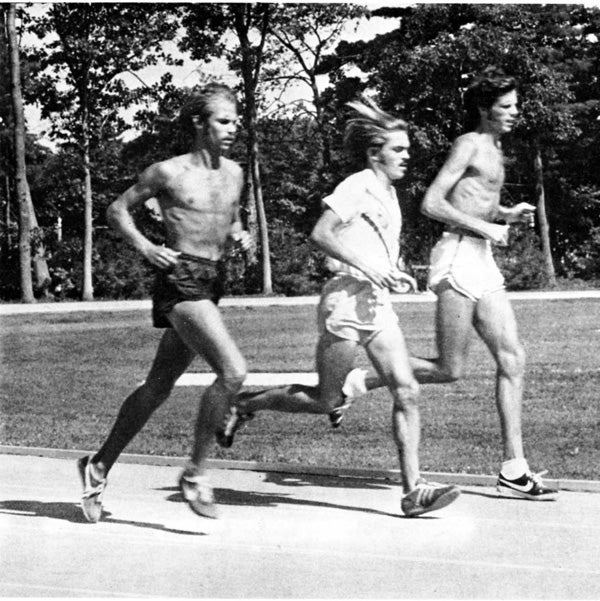
1972 Men’s Marathon Trials, Eugene, Oregon
Friends Frank Shorter and Kenny Moore had an easy time of it in Eugene, where Moore lived. They won the Trials by almost a mile, hands clasped overhead. Florida friends Jack Bacheler and Jeff Galloway also finished together, with Galloway slowing just before the line, so Bacheler would get the third spot.
This was significant, as Galloway had already gained an Olympic team berth for his third-place in the 10,000 meters. In that race, Bacheler, a co-favorite (with Shorter), was controversially disqualified. He entered the marathon, which he had never run, in a last-gasp effort to make the Olympic team. Marathon veteran Galloway then paced his friend through the marathon.
Lesson Learned: Bacheler made the Olympic team because Galloway showed him how. For novice marathoners, there’s nothing like an experienced competitor to explain the essentials. Seek out local wisdom. It’s even better if you can train with some veterans, and maybe even run your marathon with one or two.
Postscript: Four days after the Israeli massacre at the Munich Olympics, Shorter won gold in the Marathon, the first American victory since 1908. Moore placed fourth. Moore’s article about the massacre and the marathon race launched his long, illustrious writing career at Sports Illustrated.
- Moore, Kenny 2:15:58
- Shorter, Frank 2:15:58
- Bacheler, Jack 2:20:30
- Galloway, Jeff 2:20:30

1984 Women’s Marathon Trials, Olympia, Washington
With the International Olympic Committee having added a women’s marathon to the Olympics, and the Olympics taking place in Los Angeles, attention on the first U.S. Olympic Marathon Trials for women was sky-high. Not only that, but the U.S. had a genuine superstar in the event—Joan Benoit. A year earlier, she has run an unprecedented 2:22:43 to win the Boston Marathon.
Just one problem: Benoit developed a knee twinge in training, and finally opted for surgery just 17 days before the Trials. In any other country, she would have been hand-picked to the Olympic Team, and let everyone else fight for the other two spots. But that’s not how the U.S. Trials system works.
So Benoit lined up at the start not knowing if her knee could handle the distance. It did. “I knew my legs could go at any point,” Benoit said post victory. “The last six miles, I couldn’t open my stride. If it had come to a finishing kick, I wouldn’t have been able to.”
Lesson Learned: Injuries happen to marathon runners, often in the last month prior to the big event. Here’s hoping you don’t need surgery like Benoit. But even if you miss several weeks of training, you can still run a strong marathon. Think of those missed weeks as a good taper, alter your expectations as necessary, and don’t run if you risk serious injury.
Postscript: Benoit won the first Olympic Marathon for women in a 23-mile breakaway effort over the likes of Grete Waitz, Ingrid Kristiansen, and Rosa Mota. Lisa Larsen, fourth in the 1984 Trials, would also finish fourth in 1988 and 1992, making her the all time hard luck Trials runner.
- Joan Benoit 2:31:04
- Julie Brown 2:31:41
- Julie Isphording 2:32:26
- Lisa Larsen 2:33:10
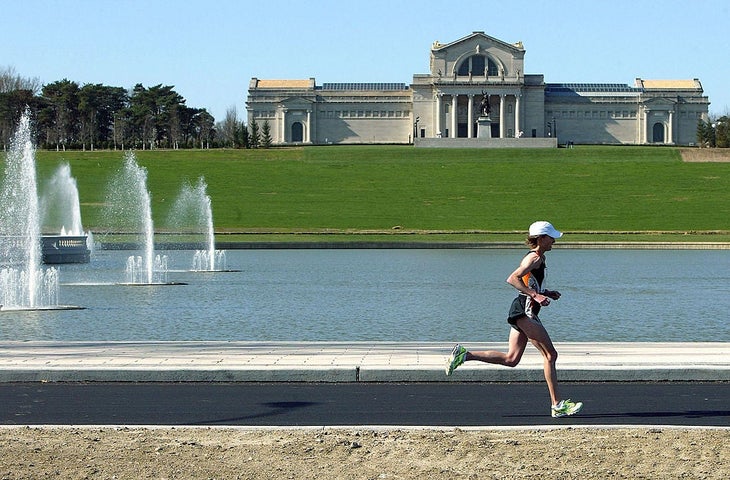
2004 Women’s Marathon Trials, St. Louis
Twenty years after Benoit, Deena Kastor was the new Joanie. She had even improved Benoit’s U.S. fastest time in the marathon, running a 2:21:06 the previous October at Chicago. It seemed she might win the St. Louis Trials by 5 minutes.
Of course, Kastor was too smart for that. She held back in the early going, and didn’t ease into the lead until 17 miles. At 20, it looked like a stroll in the park, literally—Forest Park, where the Trials were held. Then, boom! The marathon can do that to you. Past 23 miles, Kastor turned pale, her stride looked wobbly, and Colleen De Reuck bolted past to grab the win. Kastor’s friend and teammate Jen Rhines closed the gap. Blake Russell was stalking both of them.
Kastor appeared in danger of losing an almost-sure-thing, and missing her first shot at the Olympic Marathon. However, she regrouped, doubled down, and held on for a valiant second-place finish. “The last three miles, I had absolutely no energy,” she said.
Lesson Learned: Fuel matters, and the last several days before a marathon are the key time to eat and hydrate appropriately. You don’t need to overeat, and you shouldn’t overhydrate, but you need to do a modest amount of both. Don’t worry if you feel slightly bloated. That’s just glycogen and water waiting to do their thing, which is what you want from them the second half of the marathon.
Postscript: Kastor ran a brilliantly paced effort in Athens to win bronze at the Olympics, covering her teary, joy-filled eyes in her final strides. She hoped for a repeat in Beijing, but suffered a fractured foot bone in the early going, and had to drop out. Blake Russell finished third in the 2008 Trials to gain the Olympic spot she missed in St. Louis.
- Colleen De Reuck 2:28:25
- Deena Kastor 2:29:38
- Jen Rhines 2:29:57
- Blake Russell 2:30:32
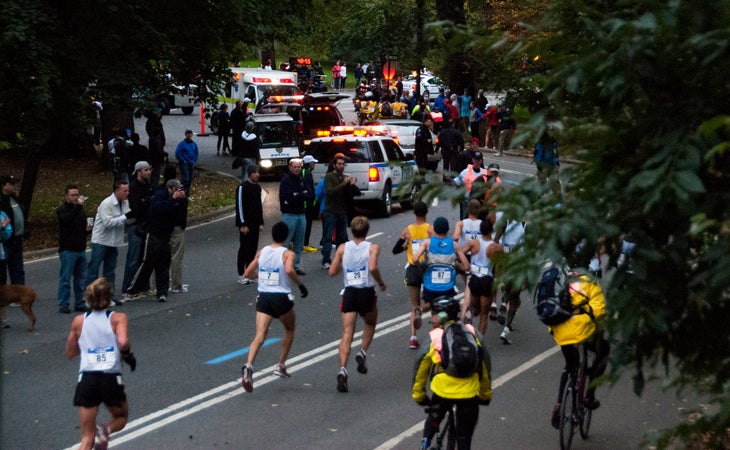
2008 Men’s Marathon Trials, New York City
We won’t quote Charles Dickens here, but we could. Let’s just say that the 2008 Trials—actually run in Central Park in November, 2007, the day before the annual NYC Marathon—was the most amazing men’s Trials ever, as well as the most tragic. In only his second marathon, Ryan Hall ran unbound over the final 13.1 miles, splitting a 1:02:45 on the undulating Central Park hills.
He didn’t know that his friend Ryan Shay had died from cardiac arrest just past the 5-mile mark. “I was just shocked when I heard,” Hall said. “It’s hard to believe a dream comes true and that I lost a friend today.”
After making the U.S. Olympic Team in 2000 and 2004, when he took silver in the Athens Marathon, Meb Keflezighi broke his hip in the 2008 Trials, and finished eighth. Brian Sell, the working man’s marathon runner, thrilled just about everyone with his third-place finish.
Lesson Learned: Marathons are full of incredible “highs” and depressing “lows.” Some days you PR, some days you DNF. Some days are far worse than a DNF. Celebrate the former, and don’t let the latter depress you. Remember what President Barack Obama said after the Boston Marathon bombings: “We carry on. We race. We strive. We build and we work and we love and we raise our kids to do the same.”
Postscript: Hall placed 10th in the Beijing Olympics, and qualified again for the 2012 London Olympics, but dropped out of that race. Keflezighi qualified for two more Olympic Marathons—2012 and 2016. Dathan Ritzenhein is expected to compete in Atlanta.
- Ryan Hall 2:09:02
- Dathan Ritzenhein 2:11:07
- Brian Sell 2:11:40
- Khalid Khannouchi 2:12:34

2016 Men’s and Women’s Marathon Trials, Los Angeles
The Trials races were as dramatic as always, especially under the blazing Los Angeles sun, but when all was said and done … we didn’t have a clue. It would take more than a year before we fully understood the historical meaning of this event. By then, Eliud Kipchoge was running laps around a car track in Italy, and Nike was promoting a shoe named the “Vaporfly 4%.”
It turned out that these very shoes had assisted three Nike runners—Galen Rupp, Amy Cragg, and Shalane Flanagan—to their Olympic-qualifying performances in Los Angeles, where the shoes had been barely noticed. Ever since, and leading up to Atlanta, they have become the biggest conversation topic in running. Everyone’s wondering what Nike shoes will appear on Feb. 29—the Alphafly?—as well as how other shoe companies will respond.
It should be noted that while three Los Angeles Trials runners gained Olympic positions in Nike shoes, three others gained spots in Brooks (Des Linden), Skechers (Meb Keflezighi), and Sauconys (Jared Ward). You can believe in the shoes if you want, but you’d be smart to bet on the athlete.
Lesson Learned: Control what you can control, and adjust to everything else. It’s nice to run for Nike with the company’s big budgets. But you can succeed in the marathon in any kind of equipment—even without shoes as Abebe Bikila did in winning the 1960 Olympic Marathon barefoot. Just focus on being the best runner you can be.
Postscript: Galen Rupp wore Vaporflys to a bronze medal in the Rio Olympics, as did the two runners ahead of him. In Atlanta, Rupp will be aiming for his fourth straight Olympic team, Linden for her third, and Cragg for her second.
WOMEN
- Amy Cragg 2:28:20
- Des Linden 2:28:54
- Shalane Flanagan 2:29:19
- Kara Goucher 2:30:24
MEN
- Galen Rupp 2:11:12
- Meb Keflezighi 2:12:20
- Jared Ward 2:13:00
- Luke Puskedra 2:14:12


